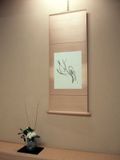Ikebana
Ikebana (Japanese: 生け花 or いけばな) is the Japanese art of making flower arrangements. The word "Ikebana" means " to make alive flowers". People who want to do Ikebana have to learn many things. It is not just about putting flowers in a vase. Japanese flower arrangements often have special meanings.
There are many ways in which Ikebana can be taught. These schools (ways of teaching) include Ikenobo, Sogetsu, Ohara.
Ikenobo is very well known. Until the Mid-Edo Period it was only for upper class people. Ikenobo was started by a Buddhist priest called Ikenobo Senkei in the 15th century. It uses standing flowers (called "rikka"). It is a Buddhist way of showing the beauty of nature. There are 7 branches. Each branch represents something in nature, e.g. a hill, valley, waterfall etc. Later, in the 17th century, it became simpler and was called "shoka". Shoka uses just 3 branches called "ten" (heaven), "chi" (earth) and "jin" (man).
Another form of Ikebana is called cha-bana. It is used in tea ceremony. ikebana is used in homes too.
Today Ikebana is very popular among all classes of people in Japan. 15 million people in Japan practice Ikebana.
Ikebana Media
Shōka arrangement by the 40th headmaster Ikenobō Senjō, drawing from the Sōka Hyakki by the Shijō school, 1820
Ikebana flower arrangement in a tokonoma (alcove), in front of a kakemono (hanging scroll)
A drawing of mitsu-gusoku, from the Senden-shō (15th–18th century)
Ikebana arrangement with cart, at the Kyoto State Guest House
Rikka arrangement by Ikenobō Senkō II, a drawing from the Rikka-no-Shidai Kyūjūsanpei-ari, Important Cultural Property
Woven bamboo flower basket (hanakago), by Living National Treasure Hayakawa Shōkosai V
Nageire of the Banmi Shofu-ryū school










